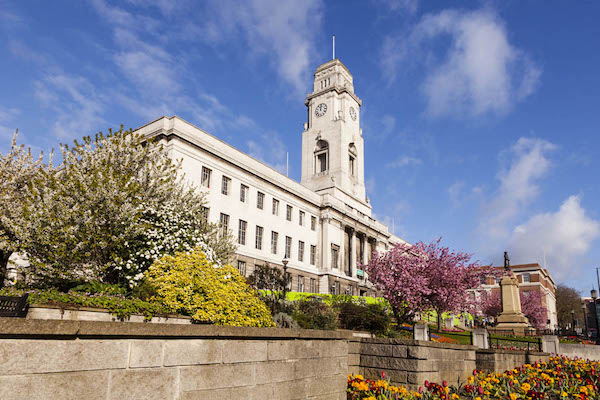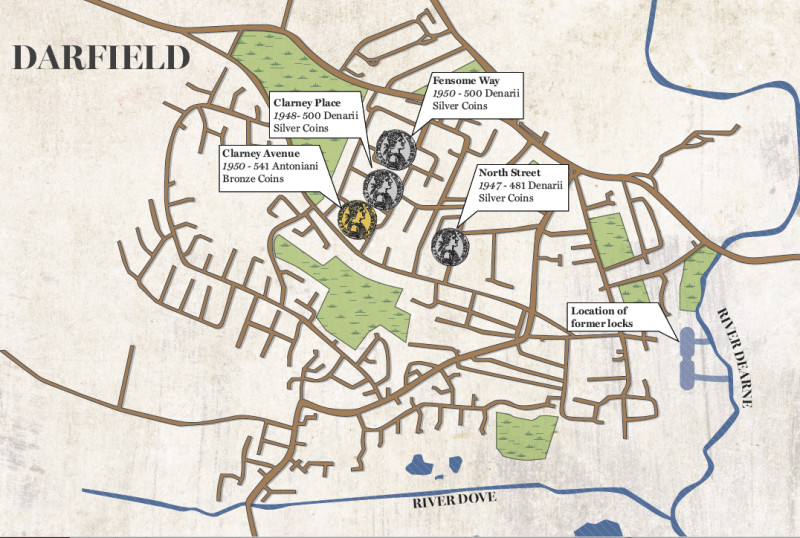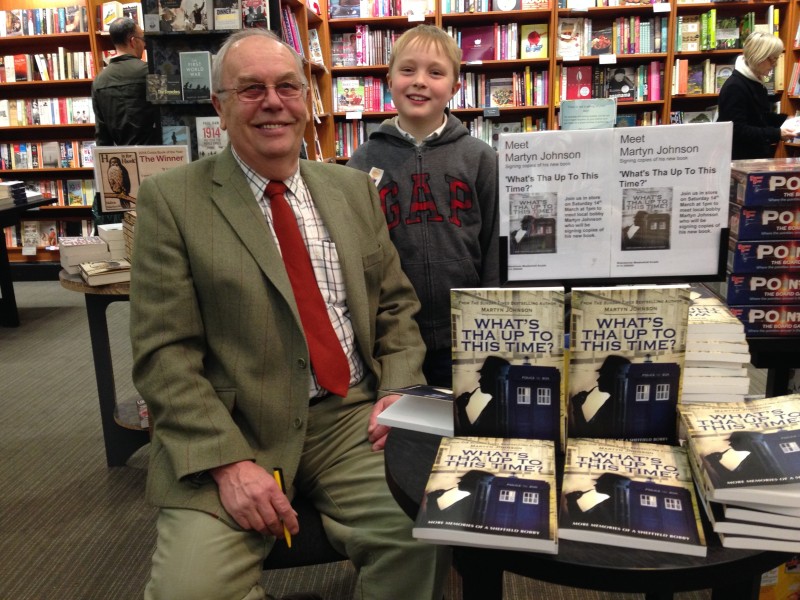ROMAN coins were once so prevalent in Darfield that kids used to trade them for conkers. In his latest instalment, Ashley Ball speaks to local historian Martyn Johnson to dig up even more on the village’s strong links to the ‘Eternal City’. The Roman empire was vast, fearsome and mighty - and it was partially powered by an inland port... in Barnsley.
It has to, at this stage, be a theory but local historian Martyn Johnson argues a cracking case for the importance of Darfield to the reigns of famous names like Vespasian, Hadrian, Marcus Aurelius and Septimius Severus.
And the evidence is there, but not exactly for all to see, as scores of hoards have been unearthed in the village over the last three centuries. Some of the discoveries are on show at Experience Barnsley within the town hall but other coins are scattered around with little or no clarity.
There have been six official discoveries of hoards but Martyn, an expert with six decades of experience to call upon, can account for many more coins being found around the village.
Martyn, now 77, and an acclaimed author after a career in the police force, was brought up in the village on Vicar Lane before moving as a seven-year old to Clarney Place on the new Tarron House estate.
He has childhood memories of coming across the almost 2,000-year-old coins and those are what set him on the path to discover more. Martyn has since become an authority on the Roman occupation of South Yorkshire, giving talks at various events and conversing with acclaimed archaeologists and historians like Barnsley’s Egyptologist Joann Fletcher and Brian Elliott.
It seems as foundations went in to Darfield in the 1940s and 50s, coins came out.
“When we were at junior school, so many of my mates were moving into the new estates in Darfield and they were finding coins, so many in fact that we were trading them for conkers,” remembers Martyn. “They didn’t mean anything to us. They were just bits of metal.
“Although there have been six recorded hoards of coins found over the years, to my own knowledge of that time I can account for 13 small ones, found at different times by neighbours and pals at school. No-one realised their importance.”
Martyn also recalls discovering a pot of coins where he and a friend shouldn’t have been as kids back in 1950. They had been larking about in a trench for the then-new housing estate on Clarney Avenue. It was after getting told off by the local bobby that Martyn was inspired to join the police but the coins stuck in his head and he pursued an interest in metal detecting.
Martyn recalls: “In the side of the trench we found lots of small green metal discs spilling out of an earthenware pot which had been split open. We were gathering handfuls and were throwing them here, there and everywhere.”
Martyn and his pal got a quick telling off and later the coins were taken away by an archaeologist. He was later to discover that the hoard included 541 coins from the third century - but Martyn feels there were many, many more.
Housing estates and further buildings have covered most of the ground where the hoards were found, but Martyn would urge anyone living in Darfield to start digging their own gardens up to see if they can catch a glimpse of the past.
“After York, the place with the most Roman coin hoards in Yorkshire, is Darfield - now there must be a good reason for that,” added Martyn. “It seems to me that nearly 2,000 years ago, Darfield was far more important than anyone had ever realised and would have been well-known in Roman times.
“From Julius Caesar’s reign, the Romans wanted to nick our minerals like tin and salt. In hot countries part of the soldiers’ pay was a salt allowance and that is where the word salary originates.
“The salt would have been mined in Cheshire and then brought over the moors to the rivers in the east of the country and then to the North Sea where it would be sent by boat to the Romans. The boats would then return to England carrying wine, oils and other commodities needed for the Roman armies.
“The mule trains would travel into South Yorkshire and, in my opinion, join the River Dearne at Darfield where the commodities would be loaded into shallow boats and sailed down the Dearne where they would join the River Don, up the Don to the Humber and out into the North Sea.”
The hoards suggest that there was vast wealth in Darfield, which means it could well have been a bustling trading point.
Evidence above the surface cemented this for Martyn. “I believe that in Roman times Darfield was a bustling inland trading point. According to old maps there used to be two fishponds, which have now been filled in, lying at the side of the River Dearne at the bottom end of Darfield. This made no sense to me whatsoever.
“In my opinion they were locks where boats could be loaded and unloaded for the return journey. Darfield, in my opinion, was an important inland port and the significant hoards found show that it would have been a massive commercial enterprise.
“Over the years I have spoken to many historians about my theories on Darfield. These include Professor David Hey, Brian Elliott, Peter Spencer (who is on the National Valuation Committee and deals with the valuation of national archaeological finds), Sam Moorhead the Roman specialist at the British Museum and Professor Joann Fletcher, the famous Egyptologist.
“Every single one of them has agreed with my thoughts on Roman Darfield, but in my opinion, being in the north is less important than if it were in the south, so nothing has been done to prove my theories.
“There must have been so much trade going on for 300 years. One of the hoards contained almost half a million pounds in today’s money. That must have belonged to somebody important.”
Professor Joann Fletcher of the University of York’s Department of Archaeology and advisor to Barnsley Arts, Museums and Archives, feels more needs to be done to find out Darfield’s links to Rome.
She said: “I totally agree with Martyn and would love to see more (archaeological studies) happen.
“Having been lucky enough to visit Darfield many times, both with Martyn and other local people who know the area well, I think he is absolutely right.
“We certainly know there have been many Roman finds right around our region, yet when it comes to Roman Britain, the focus of study has always tended to be on the south and on Hadrian’s Wall, with hardly anything in between.
“So it would be wonderful to be able to put Darfield, and indeed the whole Barnsley region, back on the map of Roman Britain - it certainly belongs there.”
The Roman occupation of England lasted almost 400 years but evidence suggests the upheaval of people back from the likes of the Dearne and Don back to the Tiber occured earlier with the burial of the coins predicted to be around 250AD - a time of turmoil in both Rome and the north of England.
Treasure, it seems, was buried around that time and never reclaimed. Darfield discoveries timeline 1680: Roman gold and other coins found in a large pot during ploughing. They were sold for just £1. 1691: 481 gold coins found in a field. They would have been worth nearly half a million in today’s money. January 1947: 481 silver coins (denarii) from the first to the third century AD were found in a pot 14 inches below the surface in a trench on North Street.
September 1948: 500 denarii from the first to the third century discovered in a pot two feet below the surface as a water main is being laid for a new housing estate at Clarney Place. Just 200 yards from the year before’s find. 1950: 541 bronze coins from the third century were found as a gas main is being laid at Clarney Avenue. 1950: 500 denarii are found at Fensome Way. A third of a mile from the other discoveries.
Martyn's passion for delving into the past was once the subject of much hilarity on Tony Capstick’s BBC Radio Sheffield show. The boyhood discovery of Roman coins ignited an unshakable interest in the past - particularly the Empire’s ruling years in England.
In 1962 he bought his first metal detector which was a surplus from the Army Stores and useless. It quickly found its way into a pond. But in 1965, and much to the annoyance of girlfriend Christine (now his wife) he purchased another metal detector and has detected all over the place - but mainly in the Lincolnshire area near the River Trent.
The former bobby has also found Roman evidence on the edge of Barnsley at Swinton, Marr and Adwick-upon-Dearne.
“It was an hilarious programme,” smiled Martyn. “We talked about metal detecting and some of my police stories and we even did a few outside programmes where Tony found a few Roman coins at Adwick-upon-Dearne and also some in Lincolnshire.
“I have been detecting 60 years but unfortunately you get people going and robbing at night and that is not what it’s about.
“You have got to be careful what you tell people. I don’t believe that anything I find is mine. Sharing history is more important and my finds have gone to local schools.
“I am just glad that I was brought up in Darfield otherwise I wouldn’t have had the interest. Everything I have found, I have given away.”
Martyn is now a Sunday Times best-selling author of the ‘What’s Tha Up To?’ series of books where he tells hilarious stories about his time on the beat in Attercliffe.








